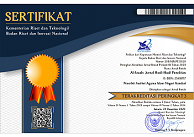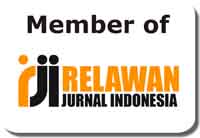Warung Kopi dan Santri; Religion in Secularcapes
Abstract
The interaction between coffee shops and Muslims has led to studies on history, philology, symbolic interaction, and pluralism. Although research on coffee shops and Muslims has emerged, there is still no one who looks at it from the perspective of religioscapes. This study aims to examine the interaction of santri in public spaces and how the impact is caused from the perspective of religioscapes. This research uses Spradley's ethnographic method, intending to analyze the phenomenon of santribehavior in coffee shops in detail. Researchers become part (live in) so that they can elaborate on the various meanings of ways of thinking and behaving in understanding human clumps. Claudia Seise's concept of Religioscapes is used as an analytical method in describing the religious state of santri in Warung Kopi Yogyakarta. This research shows that religious practices that occur in secular places, including the recitation of shalawat burdah and the recitation of yellow books on the themes of fiqh, nahwu, and tasawwufthat are routinely carried out by santri, can influence other individuals, especially from non-santri, resulting in religion in secularcapes. Coffee shops as places that are initially neutral/secular become spaces for certain religious practices, which we call religion in secularscapes. This research implies that santri can form new religious spaces, or new religioscapes in secular places, where neutral spaces become sacred and religioscapes of this model do not have the main authority, but have diffuse authority.
Keywords
Full Text:
PDFReferences
Assa’idi, Sa’dullah. “The Growth of Pesantren in Indonesia as the Islamic Venue and Social Class Status of Santri.” Eurasian Journal of Educational Research 21, no. 93 (April 30, 2021). https://doi.org/10.14689/ejer.2021.93.21.
Azra, Azyumardi. Islam in the Indonesian World: An Account of Institutional Formation. Bandung: Mizan Pustaka, 2006.
Bruinessen, Martin van. “Kitab Kuning: Books in Arabics Script Used in The Pesantren Milieu.” Bijdragen Tot de Taal-, Land- En Volkenkunde 146, no. 2/3 (1990): 226–69. https://www.jstor.org/stable/27864122.
Burhani, Ahmad Najib. “Geert’s Trichotomy of Abangan, Santri, and Priyayi: Controversy and Continuity.” Journal of Indonesia Islam 11, no. 2 (2017): 329. https://doi.org/10.15642/JIIS.2017.11.2.329-350.
Burhanudin, Jajat. Ulama Dan Kekuasaan: Pergumulan Elite Politik Muslim Dalam Sejarah Indonesia. Bandung: Mizan, 2012.
Dhofier, Zamakhsyari. Tradisi Pesantren: Studi Pandangan Hidup Kyai Dan Visinya Mengenai Masa Depan Indonesia. Jakarta: LP3Es, 2011.
Flanagan, Mariah Camille. “The Religioscape Of Museums: Understanding Modern Interactions With Ancient Ritual Spaces.” University of Pittsburgh, 2017.
Habermas, Jurgen. “The Structural Transformation of the Public Sphere: An Inquiry into a Category of Bourgeois Society.” Choice Reviews Online 27, no. 07 (1990): 27-4175-27–4175. https://doi.org/10.5860/CHOICE.27-4175.
Hattox, Ralph S. “Coffee and Coffeehouses: The Origins of a Social Beverage in the Medieval Near East.” The American Historical Review 92, no. 4 (1987): 1010. https://doi.org/10.2307/1864072.
Hayden, Robert M., and Timothy D. Walker. “Intersecting Religioscapes: A Comparative Approach to Trajectories of Change, Scale, and Competitive Sharing of Religious Spaces.” Journal of the American Academy of Religion 81, no. 2 (2013): 399–426. https://doi.org/10.1093/jaarel/lft009.
Horowitz, Elliott. “Coffee, Coffeehouses, and the Nocturnal Rituals of Early Modern Jewry.” AJS Review 14, no. 1 (1989): 17–46. https://www.jstor.org/stable/1486283.
Igboin, Benson Ohihon. “COVID-19, Food and Freedom to Worship: An Analytic Approach to Nigeria’s Religioscape.” In Global Health, Humanity and the COVID-19 Pandemic, 401–25. Cham: Springer International Publishing, 2023. https://doi.org/10.1007/978-3-031-17429-2_18.
Kanungo, Pralay. Construction and Transformation of a Sacred City: The Religioscape of Varanasi. De Gruyter, 2022. https://doi.org/10.1515/urbrel.11276431.
Khoo, Gaik Cheng. “Kopitiam: Discursive Cosmopolitan Spaces and National Identity in Malaysian Culture and Media.” In Everyday Multiculturalism, edited by Amanda Wise and Selvaraj Velayutham, 87–104. London: Palgrave Macmillan UK, 2009. https://doi.org/10.1057/9780230244474.
Kilde, Jeanne Halgren. “The Impermanence of Religious Space: Three Models for Approaching Change in the American Religioscap.” In The Oxford Handbook of Religious Space, 100–114. Oxford: Oxford University Press, 2022. https://doi.org/10.1093/oxfordhb/9780190874988.013.23.
Kulkarni, Deepali D. “Digital Mūrtis, Virtual Darśan and a Hindu Religioscape.” Nidan: Nidan : International Journal for Indian Studies 3, no. 2 (2018). https://doi.org/https://hdl.handle.net/10520/EJC-1273db35e9.
Mahzumi, Fikri. “Kitab Kuning: Jejak Intelektualisme Pesantren,” 2016. https://www.researchgate.net/publication/295858176_Kitab_Kuning_Jejak_Intelektualisme_Pesantren.
Misbah, Aflahal. “Kopi, Warung Kopi, Dan Potensi Studi Keislaman.” Al-A’raf : Jurnal Pemikiran Islam Dan Filsafat, 2018. https://doi.org/10.22515/ajpif.v15i2.1384.
———. “POTRET LANSKAP HARMONI DALAM PROSES PROPAGASI SUFISME DI WARUNG KOPI YOGYAKARTA.” Harmoni 17, no. 1 (June 30, 2018): 88–104. https://doi.org/10.32488/harmoni.v17i1.286.
———. “Sufisme Dan Warung Kopi: Dialog ‘Pengajian Sufi’ Dengan ‘Masyarakat Warung Kopi’ Di Yogyakarta.” Esoterik, 2018. https://doi.org/10.21043/esoterik.v4i2.4050.
Nihaya, Ulin. “KONSEP SENI QASIDAH BURDAH IMAM AL BUSHIRI SEBAGAI ALTERNATIF MENUMBUHKAN KESEHATAN MENTAL.” Jurnal Ilmu Dakwah 34, no. 2 (December 24, 2014): 295–308. https://doi.org/10.21580/jid.v34.2.488.
Rojikhin, Khoirur, and Muhammad Turhan Yani. “Ngaji Warung Kopi Sebagai Upaya Penguatan Pendidikan Karakter Kepedulian Sosial Pemuda Di Kecamatan Kenjeran Kota Surabaya.” Kajian Moral Dan Kewarganegaraan 11, no. 1 (August 11, 2022): 192–105. https://doi.org/10.26740/kmkn.v11n1.p192-105.
Seise, Claudia. “Islamic Authority Figures and Their Religioscapes in Indonesia.” Teosofia: Indonesian Journal of Islamic Mysticism 10, no. 1 (April 26, 2021): 37–58. https://doi.org/10.21580/tos.v10i1.8441.
———. Religioscapes in Muslim Indonesia: Personalities, Institutions and Practices. Berlin: regiospectra Verlag, 2020.
Shiddiq, Ahmad. “TRADISI AKADEMIK PESANTREN | TADRIS: Jurnal Pendidikan Islam,” 2016. http://ejournal.iainmadura.ac.id/index.php/tadris/article/view/826.
Sohrabi, Narcisse M. “Coffee Shop (Café), Public Sphere for Further Reflections on Social Movements (Case Study: Tehran, Capital of Iran),” 2015, 18.
Spradley, James P. The Etnographic Interview. Harcourt Brace Jovanovich Collage Publishers, 2007.
Sumarsana, Utju. “Safinah an-Najat: Kitab Kuning Mengenai Fikih bagi Santri Pemula di Indonesia.” SOSIOHUMANIKA 2, no. 1 (2009). https://doi.org/10.2121/sosiohumanika.v2i1.346.
Sweetser, Heather M. “A Chapter in the History of Coffee: A Critical Edition and Translation of Murtada Az-Zabidi’s Epistle on Coffee.” The Ohio State University, 2012. https://etd.ohiolink.edu/apexprod/rws_olink/r/1501/10?clear=10&p10_accession_num=osu1339184075.
Trantas, Georgios. “Greek-Orthodox Migrant Religioscape Markers, Heterotopias and Entopias.” In Politics, History and International RelationsSchool of Social Sciences and Humanities. Leeds, UK: ConferenceBASR Annual Conference, 2019.
Ulum, Miftachul. “Eksistensi Pendidikan Pesantren : Kritik Terhadap Kapitalisasi Pendidikan.” TA’LIM : Jurnal Studi Pendidikan Islam 1, no. 2 (2018): 240–57. http://e-jurnal.unisda.ac.id/index.php/talim/article/view/949.
Ulum, Mokhamad Miptakhul. “Metode Membaca Kitab Kuning Antara Santri Dan Mahasiswa.” Islamic Review: Jurnal Riset Dan Kajian Keislaman 7, no. 2 (2018): 120–36. https://doi.org/10.35878/islamicreview.v7i2.141.
William, Sister Mary, and Clifford Geertz. “The Religion of Java.” The American Catholic Sociological Review 22, no. 1 (1961): 59. https://doi.org/10.2307/3708141.
Zukin, Sharon. “Urban Lifestyles: Diversity and Standardisation in Spaces of Consumption.” Urban Studies 35, no. 5–6 (1998): 825–39. https://doi.org/10.1080/0042098984574.
DOI: http://dx.doi.org/10.31332/ai.v0i0.7120
Copyright (c) 2023 Muhammad Muqronul Faiz, Abdulloh Hadziq

This work is licensed under a Creative Commons Attribution-NonCommercial-ShareAlike 4.0 International License.










